In recent years, yoga has become so popular all over the world that even its new offshoots (fly yoga, yoga in tandem) have begun to appear. Pair yoga (aka yoga in unison, friendly yoga, yoga of trust) deserves a separate story, since it pays a lot of attention not only to physical preparation and the correct execution of the elements, but also to the psychological component of the relationship between two people who decided to merge in one asana on two.
What is pair yoga useful for, with whom it can be practiced and what poses are suitable for beginners – read the article estet-portal.com.
How does pair yoga begin — choice of partner and suitable asanas
The essence of pair yoga is already hidden in its very name — all asanas in this type of yoga are performed simultaneously by two people in a single bundle. Standing in traditional yoga poses, with their counterweight, partners help each other maintain balance, bend or stretch better.
Since each of the participants serves as a physical support and support for the second (because of this, sometimes this variety is even called lazy yoga), pair yoga becomes an ideal option in order to learn how to do complex asanas, which a person are not yet available in ordinary yoga, or learn to perform more familiar asanas.
Even if you — a beginner in any kind of yoga, you can not be afraid to start practicing pair yoga (but at the initial stages only under the supervision of an experienced instructor!), because in it all the poses and even elements of acrobatics are much easier than it seems at first glance.
Before diving into the depths of a new world, of course, you will first have to choose a good practice partner. Instructors advise beginners to pair up with a more experienced yogi at first, but this is not a prerequisite.
If you are in the studio, you can try the exercises with any member of your band — experienced yogis say that yoga in tandem brings even strangers very close. However, it is worth noting that not all introverts will want to entrust themselves and their bodies to a stranger, so such a random choice is not suitable for everyone. If you still decide, then before starting the lesson, hold hands, stand back to back — this advice may sound a little strange, but it's proven. If you do not have sympathy and warmth for a partner, then it is better not to start pair lessons.
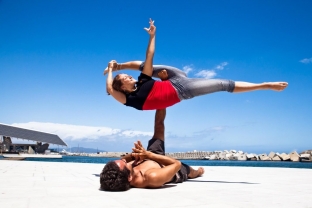
Most yogis consider pair yoga classes with their loved one to be the ideal option. It is not for nothing that sometimes paired asanas of lovers are compared even with tantra yoga, in which there is an exchange of sexual energies. Pair yoga will also have a beneficial effect on the relationship of lovers, making them deeper, more harmonious, and more diverse. You will learn to understand each other literally without words! In addition, the well-being and mood of both partners — a guarantee of a fulfilling personal life (we are now talking about the side of it that remains behind the closed doors of the bedroom).
If for any reason your soul mate doesn't want or can't keep you company, it doesn't matter. Girlfriend/boyfriend, relative, even a teenage child — any person with whom you have a good relationship is suitable for pair yoga classes.
There is only one condition: your partner should not differ significantly from you in weight, otherwise it will be very difficult for one of the two; besides, these will be traumatic activities for the lighter tandem member.
When you already have a partner, you can go directly to the asanas.
In each of them you need to linger for 4-6 cycles of "inhale-exhale"; (if both partners are physically prepared, it is possible for 1-2 minutes). You can not make sudden movements — you need to enter and exit asanas smoothly and slowly. Warm up before starting class.
During the lesson, do not forget to ask your partner if he is comfortable. Also, do not be silent if the position suddenly exceeded your physical capabilities or if your partner accidentally caused you discomfort.
The following poses are for beginners in couple yoga.
Dancing Shiva Pose
Teaches coordination and balance.
Participants facing each other place hands in front of them, raise the bent leg and interlace it with the partner's leg. Now try to breathe calmly and keep your balance, looking into each other's eyes.
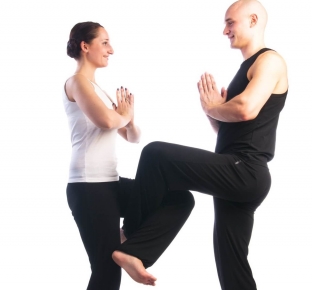
Parallel Standing Bend
Partners reach head to foot, bending forward and standing back to back. At the same time, their hands clasp each other's knees.
With this pose you will stretch the muscles of the back, lower back and hips well, as well as stretch the spine and relax the back.
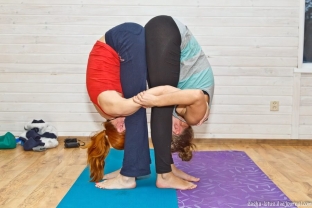
Couple in a boat
In traditional yoga, beginners usually take a long time to learn this asana, as they have to balance on one point of the body. But in pair yoga, partners support each other, so it’s easy to sit in this position the first time. The benefits of this asana — wagon and small cart: practically all the main muscles of the body are strengthened (abs, back, hips and legs).
First you need to sit facing each other with your legs bent. Then, holding hands, you need to smoothly raise your legs (one at a time), connecting the feet to each other. It will be easier to stay in the pose if you synchronize the rhythm of breathing with your partner.
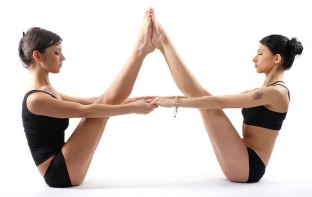
Tilt to legs
Stretches the muscles of the body, arms, outer thighs.
The couple sits face to face and holds hands, connecting with their feet. Legs slightly bent at the knees or straight (if stretching allows). The back and neck remain perfectly even all the time!
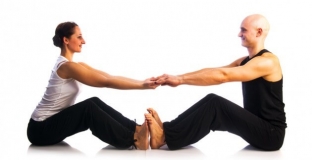
For beginner yogis, a few simple poses will be enough for the first classes.
Pair yoga classes will not only strengthen confidence in a person, but will also perfectly remove your personal energy clamps and psychological barriers. In women, pair yoga develops tenderness, openness, sensitivity and calmness, and in men — confidence and firmness. Therefore, it is definitely worth a try!
Read also: The benefits of yoga: 3 main reasons to do this practice






Add a comment